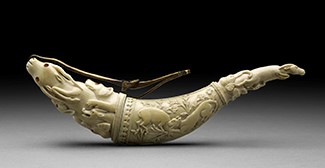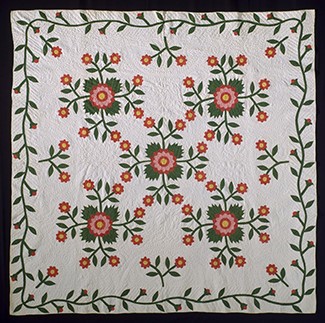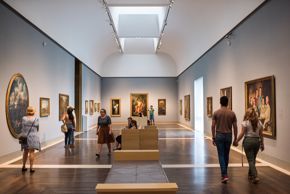Must-See Art This Fall, Handpicked by MFAH Curatorial Staff September 20, 2016
The days are shorter and the shadows are longer, but fall doesn’t just mean a change in season. Discover the multitude of meanings that autumn holds across time and cultures with these curatorial staff picks of works from the MFAH collections. Read the curators’ notes, then find the autumn-inspired art on view in our permanent collection galleries!

Camille Pissarro, The Goose Girl at Montfoucault (White Frost), 1876
Location: Beck Building, 2nd floor
“Geese won’t go over well,” wrote the ever-struggling Camille Pissarro, but he felt compelled to paint what was before his eyes and did so with a profound feeling for nature. He observed this scene while staying at his friend Piette’s farm in Brittany in the fall of 1876. The white frost typical of cold autumn nights is just giving way under the soft morning sunlight, so beautifully captured by Pissarro’s brush. —Helga Aurisch, curator, European art

Chinese, Vase, 1662–1722
Location: Law Building, 1st floor
Spoiled by my graduate school experience in Boston—where the leaves change in autumn—I associate the fall season with a dusky color palette. Orangey reds, golden yellows, velvety browns are hard to come by in Houston’s eternal summer, but a visit to the Arts of China gallery can satisfy the need to admire some fall colors. This delightful 17th-century Chinese vase features a beautifully delicate “peachbloom” glaze, created from firing a tricky copper-based glaze at over 2,000 degrees Fahrenheit! —Beatrice Chan, curatorial assistant, Asian art

Wari, Figural Bottle with Death Mask, 650–900 AD
Location: Law Building, 2nd floor
My favorite fall holidays are Halloween and Día de los Muertos, when the veil between this world and the next is thought to be a little thinner. That’s one reason why I find art of the ancient Americas so appealing: A lot of this art deals with death and its intimate relation to life. I hope that doesn’t sound too morbid, because for me, it’s about the celebration of life. —Chelsea Dacus, assistant curator, antiquities, the Glassell Collections, and arts of African, Oceania, and the Americas

American, Whig Rose Surface-Appliqué Quilt, c. 1850–70
Location: Bayou Bend, Folk Art Room
Many Bayou Bend visitors may not know that Ima Hogg collected quilts and coverlets for the Bayou Bend Collection. This fall, for the first time in the house, a quilt is displayed on the wall in the Folk Art Room. A different quilt will switch out every four months. This beautiful American appliqué quilt was hand-stitched in the mid-1800s with bright red flowers. As fall approaches with colder weather, and leaves begin to change color, I imagine many us will want to wrap up in our own quilts at home. —Remi Dyll, curatorial and programs liaison, Bayou Bend

Indian (Mughal), Powder Flask, 17th century
Location: Law Building, 1st floor
As fall approaches, many Texans look forward to hunting season. In 17th-century India and Iran, hunting was a popular princely outdoor pursuit. This delicately carved ivory flask belies its function as a container for gunpowder. Also on view in this Islamic art gallery is a ceramic bottle featuring a lively hunt scene of a man shooting a deer and a crane flying away. And don’t miss the fabulous archers’ thumb rings in the al-Sabah installation! —Aimée Froom, curator, Islamic Art

Bryan Hunt, Big Twist, 1978
Location: Cullen Sculpture Garden
Although some people may not immediately associate Bryan Hunt’s Big Twist with fall, for me this work poetically evokes the stillness and silence of the season. Meant to capture the fluid motion of water in bronze, the sculpture’s twisted, elongated form and textured surface also make me think of a bare tree in late autumn. Big Twist reminds us to find beauty in impermanence and stands fixed as a profoundly evocative and timeless feature of the Cullen Sculpture Garden. —Althea Ruoppo, curatorial assistant, contemporary art and special projects






